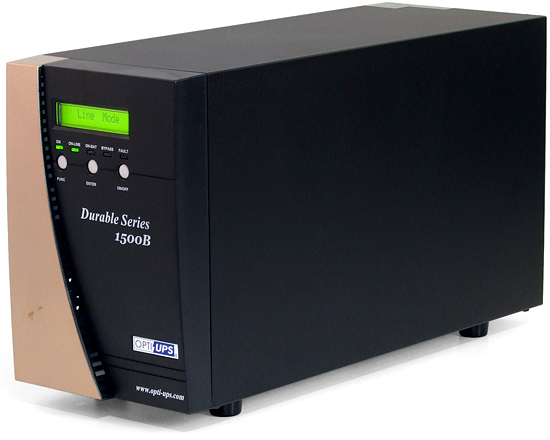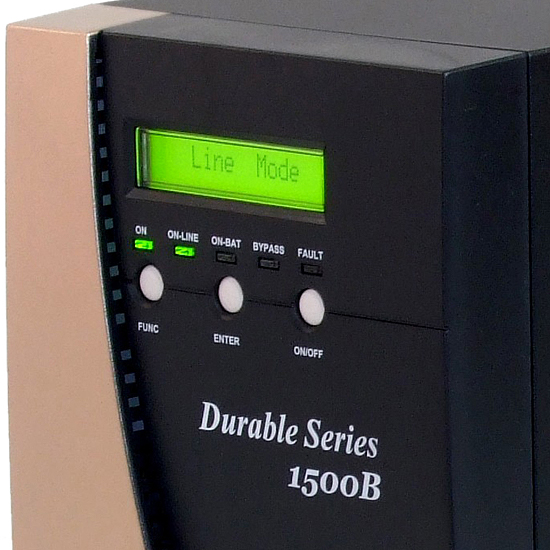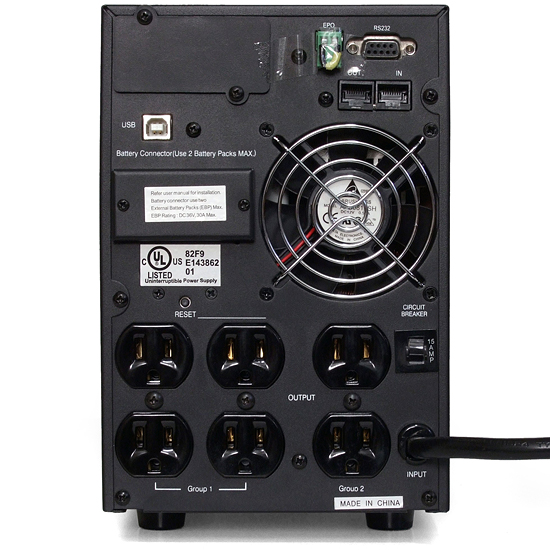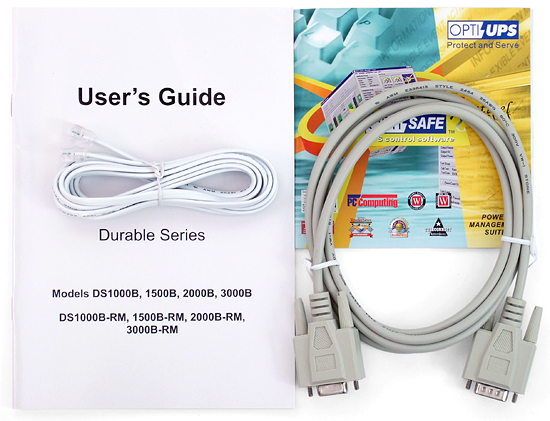Enthusiast Power Protection: Four-Way 900 W UPS Roundup
It's downright negligent to ignore the power needs of your high-end hardware. While many power users go to the trouble of tracking down solid PSUs, we recommend going a step further and investing in battery backup. We round up four enthusiast units.
Opti-UPS Durable Series DS1500B
Opti-UPS might be considered a high-value brand in the traditional consumer market, but none of its consumer products were ready to support active PFC power supplies. Stepping up to server-grade parts, it still had to go upscale to support the high loads of an enthusiast-class PC. The DS1500B is so upscale, it’s the only unit it today’s comparison to use double-conversion topology.
Double-conversion means that 100% of the output power comes directly from the batteries, while the input side is isolated from the output side through the batteries. Two completely separate power circuits are required to make this all work, but the chief benefit is that a double-conversion unit can tolerate far greater input power fluctuations without impacting stability on the output side. Because the outputs run continuously from the battery, there is no need to switch between power sources, and the batteries themselves become part of the voltage and current buffer.
A simplified front panel is less verbose than that of some competitors, but a little patience still allows users to “get the job done” without relying on software. Of course, those who don’t have much patience can just as easily install the control software to access advanced functions.
Besides having the highest capacity of today’s competitors at 1050 W, the DS1500B is also able to have the longest run time through the addition of external battery packs. On the other hand, the added cost of a double-conversion power unit means that many end users won’t have enough money left to purchase external batteries.
Two power groups allow users to configure load shedding, turning off unneeded peripherals to conserve battery life.
We were very surprised to find that the DS1500B does not include a USB cable, since very few modern systems have retained the nine-pin serial interface. The older interface is still common on servers however, and that’s the primary market for this high-end unit.
Get Tom's Hardware's best news and in-depth reviews, straight to your inbox.
Current page: Opti-UPS Durable Series DS1500B
Prev Page CP1500PFCLCD Management Software Next Page DS1500B Management Software-
sudeshc Have been using APC for last 2 years now without any issues what so ever.Reply
Would recommend it although they might be a bit costly but they perform really well. -
hmp_goose Soooo you have nothing to say about the TripLite atoll? Dead last? Distant second? Muddled mess? Nice part for not-our-application?Reply -
dEAne I have several units of APC and a hundred after-sales issues which remains unanswered, I opted to installed the generator set and a AVR than a UPS.Reply -
Emperus Most folks would just be happy to ignore on the need for a backup power source.. Hope this article enlightens them on getting one to protect their precious components and/or be ready if and when the situation arises.. Would be great if Tom's could put up a tier based classification on suitable UPS choices for various PC's (gaming, server, home theatre etc.)..Reply -
super_tycoon What about AVR? (Automatic Voltage Regulation) I have a CP1500AVRLCD and I've seen (at least I'm pretty sure) I've seen the AVR feature kick in when one of the local power lines got knocked out and the voltage drooped to ~100. (killed some of my non-dimmable cfl's) I went to CP's website and it claimed the pfc units still have AVR functionality. So here comes the confusion, what's the point of the voltage tolerances? If it has an AVR, why would it matter what voltage it's fed as long as there steps on the transformer? I thought the unit was supposed to take 90-140 without having to engage the battery while still passing ~120v?Reply
You've also made me want to test my non-pfc ups with my 850hx, but my gaming rig and my workstation are an hour apart.... -
aldaia This is a quite inefficient & expensive approach to the problem. We take AC and use a transformer to convert to DC and store in a battery, meanwhile another transformer is also taking AC and converting to DC to feed our components. When there is a blackout, we take DC from the battery, convert to AC and feed the computer PS where we convert back to DC to feed our components. Wouldn't be more cost effective and energy efficient to use the same unit to both feed our components with DC and the battery? Most of the time a PS has a surplus of power that can be used to charge the battery. When there is a blackout we could just take DC from battery and feed our components without the inefficient double DC->AC->DC conversion. I think an integrated UPS/PS would be cheaper (most components are replicated). That would be enough for most enthusiasts, that only need a relatively short battery life to be able to save work. A different matter is in professional environments where a UPS feeds dozens of computers that cannot be stopped. ¿Anyone knows if such a think exists?Reply -
wrxchris I've been using a CyberPower 1350AVR for the past couple years and it has been great. Gives me approx. 17 mins of runtime at idle / basic tasks (approx. 250 watts between my rig and main LCD). It's good for 810W, and I believe I picked it up on sale for $120.Reply -
g00ey I've always been wondering about the possibilities to replace the small batteries in those UPSes with standard car batteries or deep cycle (marine) batteries. Since the batteries in the UPSes are standard 12V lead cells it shouldn't be a problem and this would be a cheap way to keep the computer alive for days without external power.Reply -
nebun g00eyI've always been wondering about the possibilities to replace the small batteries in those UPSes with standard car batteries or deep cycle (marine) batteries. Since the batteries in the UPSes are standard 12V lead cells it shouldn't be a problem and this would be a cheap way to keep the computer alive for days without external power.wrongReply




